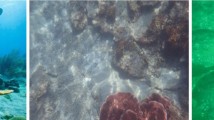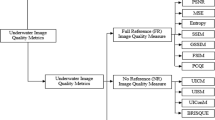Abstract
Image capture systems fail to capture high-resolution images when used at great depth underwater, and the equipment is also expensive. With the use of image processing algorithms, it is possible to reconstruct and improve image quality without any costly and reliable image acquisition programs. Developing and rebuilding an underwater image is a daunting task and has gained momentum in recent years. The aim is to improve underwater images by removing graininess, fine-tuning, and sharpening the images using deep learning models.In this work, the authors train four Convolution Neural Network (CNN) based models (two 3-layered and two 5-layered) over GAN-augmented datasets viz. EUVP (Enhancing Underwater Visual Perception)and UIEB (Underwater Image Enhancement Benchmark). Comparisons of these four models are done with the state-of-the-art methods with the aim of identifying the best model. The results showed that the 5-layered model with SGD optimizer performs the best.




















Similar content being viewed by others
Data availability
Data is available with the authors and will be provided on request.
References
Anwar S, Li C, Porikli F (2018) Deep underwater image enhancement. arXiv preprint arXiv:1807.03528, 1–12
Cao K, Peng YT, Cosman PC (2018), April underwater image restoration using deep networks to estimate background light and scene depth. IEEE Southwest Symposium on Image Analysis and Interpretation (SSIAI), 1–4
Chen X, Yu J, Kong S, Wu Z, Fang X, Wen L (2018) Towards quality advancement of underwater machine vision with generative adversarial networks, 1–20
Ding X, Wang Y, Zhang J, Fu X (2017) Underwater image dehaze using scene depth estimation with adaptive color correction. OCEANS 2017-Aberdeen, 1–5
Gupta M, Kumar N, Gupta N, Zaguia A (2022) Fusion of multi-modality biomedical images using deep neural networks. Soft Comput 26:8025–8036
Hu K, Weng C, Zhang Y, Jin J, Xia Q (2022) An overview of underwater vision enhancement: from traditional methods to recent deep learning. J Mar Sci Eng 10(2):1–35
Hu K, Zhang Y, Weng C, Wang P, Deng Z, Liu Y (2021) An underwater image enhancement algorithm based on generative adversarial network and natural image quality evaluation index. J Mar Sci Eng 691:1–18
Karan A, Mijwil MM, Sonia MAH, Alomari S, Gök M, Alaabdin Z, Abdulrhman SH (2022) Has the future started? The current growth of Artificial Intelligence, Machine Learning, and Deep Learning. Iraqi J Comput Sci Math 3(1):115–123
Kodepogu KR, Annam JR, Vipparla A, Krishna BVNVS, Kumar N, Viswanathan R, Gaddala LK, Chandanapalli SK (2022) A novel deep convolutional neural network for diagnosis of skin disease. Traitement Du Signal 39:1873–1877
Kumar N, Hashmi A, Gupta M, Kundu A (2022) Automatic diagnosis of Covid-19 related pneumonia from CXR and CT-Scan images. Eng Technol Appl Sci Res 12(1):7993–7997
Li H, Zhuang P (2021) DewaterNet: a fusion adversarial real underwater image enhancement network. Sig Process Image Commun 95:1–10
Li C, Guo J, Guo C (2018) Emerging from water: underwater image color correction based on weakly supervised color transfer. IEEE Signal Process Lett 323–327:1–10
Li C, Anwar S, Hou J, Cong R, Guo C, Ren W (2021) Underwater image enhancement via medium transmission-guided multi-color space embedding. IEEE Trans Image Process 4985–5000:1–16
Li C, Guo J, Guo C, Cong R, Gong J (2017) A hybrid method for underwater image correction. Pattern Recog Lett 62–67:1–9
Li J, Skinner KA, Eustice RM, Johnson-Roberson M (2017) WaterGAN: unsupervised generative network to enable real-time color correction of monocular underwater images. IEEE Robot Autom Lett 387–394:1–7
Liu X, Gao Z, Chen BM (2021) IPMGAN: integrating physical model and generative adversarial network for underwater image enhancement. Neurocomputing 538–551:1–13
Sarma K, Vigneshwaran P (2021) Underwater image enhancement using deep learning. In: International conference on image processing and capsule networks, pp 431–445, 1–40
Scattering (2018) Retrieved April 25, 2022, from https://en.wikipedia.org/wiki/Scattering
Sun X, Liu L, Li Q, Dong J, Lima E, Yin R (2019) Deep pixel-to-pixel network for underwater image enhancement and restoration. IET Image Process 469–474, 1–15
Wang K, Hu Y, Chen J, Wu X, Zhao X, Li Y (2019) Underwater image restoration based on a parallel convolutional neural network. Remote Sens 1591:1–21
Wang Y, Guo J, Gao H, Yue H (2021) Uiecˆ 2-net: CNN-based underwater image enhancement using two color space. Signal Process Image Commun 96:1–45
Yang M, Hu K, Du Y, Wei Z, Sheng Z, Hu J (2020) Underwater image enhancement based on conditional generative adversarial network. Sig Process Image Commun 81(115723):1–19
Zhang H, Sun L, Wu L, Gu K (2020) Dugan: an effective framework for underwater image enhancement. IET Image Process 15:1–10
Author information
Authors and Affiliations
Corresponding author
Additional information
Publisher’s note
Springer Nature remains neutral with regard to jurisdictional claims in published maps and institutional affiliations.
Rights and permissions
Springer Nature or its licensor (e.g. a society or other partner) holds exclusive rights to this article under a publishing agreement with the author(s) or other rightsholder(s); author self-archiving of the accepted manuscript version of this article is solely governed by the terms of such publishing agreement and applicable law.
About this article
Cite this article
Kumar, N., Manzar, J., Shivani et al. Underwater Image Enhancement using Deep Learning. Multimed Tools Appl 82, 46789–46809 (2023). https://doi.org/10.1007/s11042-023-15525-4
Received:
Revised:
Accepted:
Published:
Issue Date:
DOI: https://doi.org/10.1007/s11042-023-15525-4




